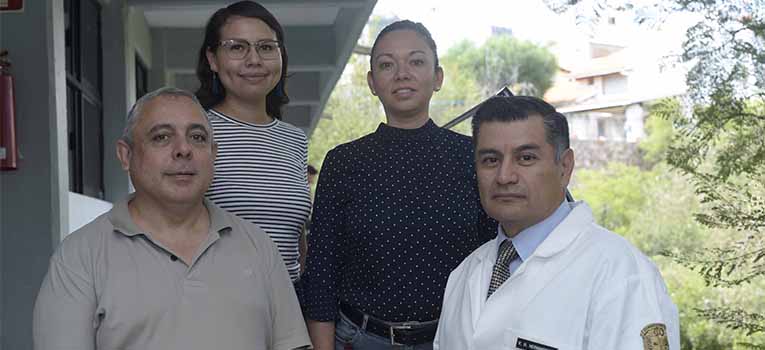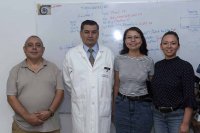
León, Gto., November 28, 2019.- In order to describe and identify the characteristics and effects of a type of nervous system diseases called Tubulinopathies, three researchers and a young student of the master's degree in Applied Sciences at the University of Guanajuato (UG) Campus Leon study in detail the first case found in Mexico of this condition.
Tubulinopathies are of genetic origin and produce brain malformations with great side effects on the lifestyle and health of patients; the first case found in Mexico is a minor originally from the state of Chiapas.
This project, led by the team belonging to the Division of Science and Engineering, is carried out in close collaboration with researchers from the Department of Chemical, Electronic and Biomedical Engineering composed by Dr. Silvia Alejandra López Juárez, Dr. Víctor Hugo Hernández González, Dr. Arturo González Vega, in addition to a collaboration with the Center for Research in Optics (CIO) where the microscopic studies of this project are carried out and with the Neurology group of the Rehabilitation Center and Children Inclusion Telethon (CRIT) Chiapas.
It is noteworthy that this important research obtained the first place at the XLIII Annual Meeting of the Mexican Academy of Neurology held in Puerto Vallarta, Jalisco, in the free works modality.
Dr. Víctor Hugo Hernández González commented in interview: "this is the first case reported in Mexico, we have described this and will be exhibited at the Congress of the Mexican Academy of Neurology and published in a specialized journal of international circulation".
She highlighted the work of Ángeles Garduño Robles, a student of the master's degree in Applied Sciences, who with this work elaborates her thesis to obtain the degree of teacher, the student has focused on carrying out the genetic and cell studies of this disease.
Therefore, the young woman performed experimentation on an animal model, which has the same characteristics of the affected patients, as it has a mutation in the same gene as the patients; so, the morphology of the animal's central nervous system is studied.
For her part, Dr. Silvia Alejandra López shared in an interview that she oversees the part of cell biology in which the animal model presented by tubulinopathy is analyzed "I am studying what happens with neurons and with the oligodendrocytes that is generated throughout life, from the part where all these neurons are generated in the perinatal period and also in the adult life."
Asimismo, el Dr. Arturo Vega González, otro integrante del grupo multidisciplinario se encarga del análisis de las imágenes que se han tomado tanto de los modelos animales como los estudios de resonancia magnética que se le han hecho a la paciente, esto contempla un estudio de tres meses de vida de los animalitos en el que se observa el deterioro del sistema nervioso.
What are tubulinopathies?
In addition, Dr. Arturo Vega González, another member of the multidisciplinary group is responsible for the analysis of the images that have been taken of both animal models and the MRI studies that have been done to the patient, this includes a three-month study of life of animals in which the deterioration of the nervous system is observed.
In recent years, some mutations in this protein have been described that cause severe damage and malformations in brain structures.
There are different types of tubulins, but particularly mutations in the tubulin-beta 4A gene (TUBB4A), cause severe damage to myelin, the insulating wrap and promotes nerve impulse transmission, as well as atrophy of the basal nuclei and Cerebellum. Among other functions, these two brain areas are responsible for the control of movements. Because of the structures damaged to this pathology it is specifically called H-ABC.
Clinically, patients have serious movement disturbances with spasticity, ataxia and severe cognitive deficit. Nuclear magnetic resonance imaging shows brain damage and the definitive diagnosis is made by genetic testing. Very little is known about how mutations in tubulin cause this disease. Few cases have been reported in the world, probably due to the lack of knowledge that still has of this disease and the processes that originate it.
Photo gallery




